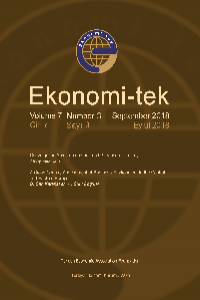The Effects of Education and Marital Status on Women’s Labor Force Participation: A Regional Analysis of Turkey
Participation of women in the labor force is important for a country’s sustainable growth and development. The rate of female labor force participation in Turkey is far below those of developed countries. Furthermore, the rate differs across regions of the country. This study investigates the effects of educational level and marital status on women’s labor force participation in the years 2006 and 2016. The aim of the study is to examine the differences across regions and to see whether the results showed any change over the ten years. Toward this end, a probit-regression model is used, with micro-level data at NUTS2 level from the Turkish Household Labor Force Survey. The results point to greater probabilities of women’s participation in the workplace in many Turkish regions over the period, but at the same time there were rigid lower participation probabilities for women, despite the rising level of education (except for higher education), in certain regions. Furthermore, we find the
participation probability of Turkish women in the labor force to be higher if they have a Bachelor’s or higher degree.
Anahtar Kelimeler:
female labor force participation, regional analysis, Turkey
The Effects of Education and Marital Status on Women’s Labor Force Participation: A Regional Analysis of Turkey
Participation of women in the labor force is important for a country’s sustainable growth and development. The rate of female labor force participation in Turkey is far below those of developed countries. Furthermore, the rate differs across regions of the country. This study investigates the effects of educational level and marital status on women’s labor force participation in the years 2006 and 2016. The aim of the study is to examine the differences across regions and to see whether the results showed any change over the ten years. Toward this end, a probit-regression model is used, with micro-level data at NUTS2 level from the Turkish Household Labor Force Survey. The results point to greater probabilities of women’s participation in the workplace in many Turkish regions over the period, but at the same time there were rigid lower participation probabilities for women, despite the rising level of education (except for higher education), in certain regions. Furthermore, we find the
participation probability of Turkish women in the labor force to be higher if they have a Bachelor’s or higher degree.
Keywords:
female labor force participation, regional analysis, Turkey,
___
- Atasoy, B. S., (2017), “Female Labor Force Participation in Turkey: The Role of Traditionalism,” The European Journal of Development Research, Vol. 29 (4), August, pp. 675-706.
- Baslevent, C. and O. Onaran, (2003), “Are Married Women in Turkey More Likely to Become Added or Discouraged Workers?”, Labor, Vol. 17 (3), pp. 439-458.
- Dayıoğlu, M. and M. Kırdar, (2010), “Determinants of and Trends in Labor Force Participation of Women in Turkey,” State Planning Organization of the Republic of Turkey and World Bank Welfare and Social Policy Analytical Work Program, Working Paper Number 5.
- Karaoğlan, D. and C. Ökten, (2015), “Labor-Force Participation of Married Women in Turkey: A Study of the Added-Worker Effect and the Discouraged-Worker Effect,” Journal of Emerging Markets, Finance, and Trade, Vol. 51, 2015 - Issue 1: Symposium: Productivity, Trade, and Development in Latin America.
- Kuznets, S., (1973), “Modern Economic Growth: Findings and Reflections,” American Economic Review, Vol. 63 (3), pp. 247-258.
- Mincer, J., (1962), “Labor Force Participation of Married Women: A Study of Labor Supply,” National Bureau Committee for Economic Research, ISBN: 0-87014-305-0, pp. 63-105.
- OECD, Statistics of Labor Force Participation (Accessed October 2017).
- Tansel, A., (1994), “Wage Employment, Earnings, and Returns to Schooling for Men and Women in Turkey,” Economics of Education Review, 13 (4), pp. 305-320.
- Tansel, A., (1996), “Self-Employment, Wage Employment, and Returns to Education for Urban Men and Women in Turkey,” in T. Bulutay (Ed.), Education and the Labor Market in Turkey, Ankara: State Institute of Statistics Publication.
- Tansel, A., (2002), “Economic Development and Female Labor Force Participation in Turkey: Time-Series Evidence and Cross-Province Estimates,” ERC Working Papers in Economics, 01/05.
- Tansel, A., (2012), 2050’ye Doğru: Nüfusbilim ve Yonetim: Đsgücü Piyasasına Bakıs, TUSİAD-T/2012-11/536.
- Tunalı, Đ., M. Kırdar, and M. Dayıoğlu, (2017), “Female Labor Force Participation in Turkey: A Synthetic Cohort Analysis, 1988-2013,” TUBITAK -Project No. 112K517.
- Turkish Statistical Institute (TURKSTAT), Household Labor Force Survey Data (Accessed August 2017).
- Winkler, A., 2016, Women’s Labor Force Participation. IZA World of Labor 2016: 289 doi: 10.15185/izawol.289.
- ISSN: 2146-6173
- Yayın Aralığı: Yılda 3 Sayı
- Başlangıç: 2012
- Yayıncı: Türkiye Ekonomi Kurumu Vakfı
